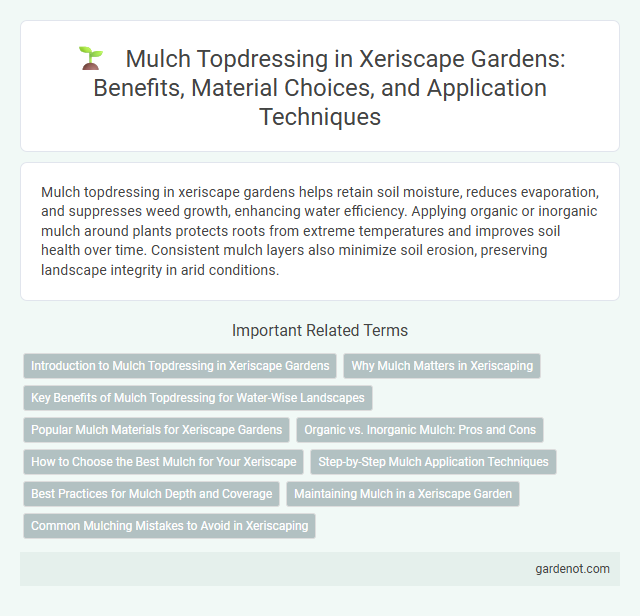Mulch topdressing in xeriscape gardens helps retain soil moisture, reduces evaporation, and suppresses weed growth, enhancing water efficiency. Applying organic or inorganic mulch around plants protects roots from extreme temperatures and improves soil health over time. Consistent mulch layers also minimize soil erosion, preserving landscape integrity in arid conditions.
Introduction to Mulch Topdressing in Xeriscape Gardens
Mulch topdressing in xeriscape gardens enhances soil moisture retention by creating a protective layer that reduces evaporation. This practice helps regulate soil temperature and suppresses weed growth, promoting the health and sustainability of drought-tolerant plants. Organic mulches, such as bark or compost, contribute to soil fertility as they decompose, improving overall garden resilience in arid landscapes.
Why Mulch Matters in Xeriscaping
Mulch topdressing plays a crucial role in xeriscaping by conserving soil moisture, reducing evaporation rates by up to 30%, and minimizing the need for frequent irrigation. It suppresses weed growth, cutting competition for water and nutrients while regulating soil temperature to protect plant roots from extreme heat. Using organic mulch also enriches soil quality through natural decomposition, enhancing plant health and sustainability in drought-prone landscapes.
Key Benefits of Mulch Topdressing for Water-Wise Landscapes
Mulch topdressing in xeriscape landscapes significantly reduces soil evaporation, enhancing water retention and reducing irrigation frequency. It suppresses weed growth, minimizing water competition and maintenance efforts while improving soil health by regulating temperature and preventing erosion. These benefits contribute directly to conserving water resources and promoting sustainable, drought-tolerant garden environments.
Popular Mulch Materials for Xeriscape Gardens
Popular mulch materials for xeriscape gardens include organic options like wood chips, bark mulch, and pine needles, which improve soil moisture retention and temperature regulation. Inorganic mulches such as gravel, decomposed granite, and lava rock are favored for their durability and minimal water absorption. Selecting the right mulch material enhances water conservation and supports drought-tolerant plant health in xeriscape landscapes.
Organic vs. Inorganic Mulch: Pros and Cons
Organic mulch, such as wood chips and bark, improves soil fertility by decomposing and adding nutrients, while enhancing moisture retention and supporting beneficial microorganisms. Inorganic mulch, including gravel or rubber, offers long-lasting durability, weed suppression, and minimal maintenance without enriching the soil. Choosing between organic and inorganic mulch depends on xeriscape goals, balancing soil health benefits against longevity and appearance preferences.
How to Choose the Best Mulch for Your Xeriscape
Selecting the best mulch for your xeriscape involves prioritizing materials that conserve moisture and regulate soil temperature effectively, such as organic options like wood chips, bark, or pine needles. Inorganic mulches like gravel or decomposed granite offer excellent drought resistance and durability while enhancing drainage and reducing weed growth. Consider factors including local climate, plant types, aesthetic preference, and soil health to ensure your mulch choice supports sustainable water use and promotes a thriving, low-maintenance landscape.
Step-by-Step Mulch Application Techniques
Begin mulch topdressing by first clearing the soil surface of weeds and debris to ensure proper soil contact. Spread a 2 to 3-inch layer of organic mulch evenly around plants, avoiding direct contact with stems to prevent rot and pest issues. Regularly replenish the mulch layer annually to maintain moisture retention, soil temperature, and weed suppression in xeriscape gardens.
Best Practices for Mulch Depth and Coverage
Mulch topdressing in xeriscape requires maintaining a consistent depth of 2 to 4 inches to maximize moisture retention and suppress weed growth effectively. Coverage should extend fully over the root zone but kept away from plant stems to prevent rot and pest issues. Using organic mulch materials like bark or shredded leaves enhances soil health by gradually decomposing and enriching the soil structure in dry landscapes.
Maintaining Mulch in a Xeriscape Garden
Maintaining mulch in a xeriscape garden is essential for water conservation and soil health, as mulch topdressing reduces evaporation and stabilizes soil temperatures. Organic mulch materials like wood chips, bark, or gravel should be replenished annually to maintain a 2 to 3-inch layer that effectively suppresses weeds and retains moisture. Proper mulch management also prevents soil erosion and supports beneficial microbial activity critical for drought-resistant plants.
Common Mulching Mistakes to Avoid in Xeriscaping
Using inappropriate mulch materials such as bark chips or colored mulch can disrupt soil moisture balance and harm drought-tolerant xeriscape plants. Applying mulch too thickly, beyond 3 inches, restricts air circulation and can lead to root rot or fungal diseases. Neglecting to maintain a mulch layer by allowing it to decompose or compact reduces its effectiveness in water conservation and weed suppression.
Mulch topdressing Infographic

 gardenot.com
gardenot.com